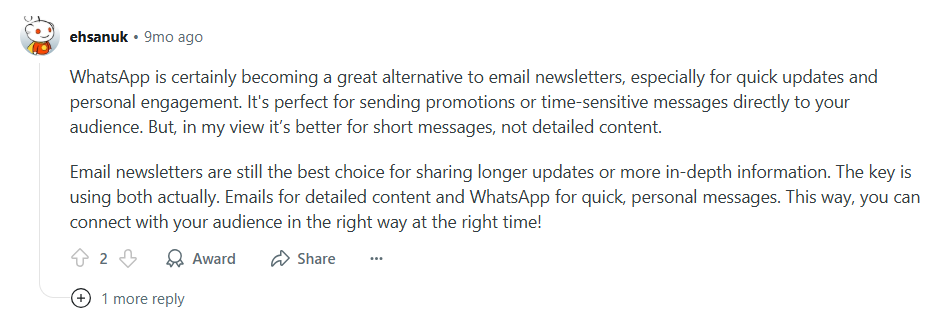Notifications pop up all too often, sometimes from friends and families, and other times from brands sending in a ‘We missed you’ nudge. For most people, these notifications include both email and WhatsApp among the other 20 apps they use.
But for brands, deciding between email and WhatsApp is tricky. Email has long been a marketing staple, but WhatsApp’s conversational edge is pushing businesses to rethink their approach.
The catch? WhatsApp has an open rate of a staggering 98%, compared to an average open rate of 21% for emails.
Let's unlock the benefits of each and discover which channel emerges as the winner.
WhatsApp vs Email Marketing: A Quick Comparison
WhatsApp conversation is immediate, conversational, and highly likely to be opened. In contrast, emails focus on building relationships through long-term communication. Let's look at their features next to each other to understand their USPs and differences better.
Advantages and Disadvantages of WhatsApp Marketing
With an understanding of WhatsApp's key functionalities, let us explore every aspect of why businesses are for and against WhatsApp marketing.
Advantages
The numerous benefits of WhatsApp marketing have made it the top marketing channel for most e-commerce businesses. Here’s why it's a go-to channel for most:
Exceptionally High Engagement
With WhatsApp, you can reach people right where they already are, chatting with their friends, responding in work groups, and skimming through conversations. This is why the platform instantly captures the interest of potential customers and encourages them to explore what you have to say.
For example, Maggi Germany’s “Chef In Your Kitchen” campaign used a WhatsApp-powered virtual assistant named Kim to guide users through recipes, answer questions, and share cooking videos.
In just eight weeks, over 200,000 messages were exchanged, resulting in a 4.2-point increase in ad recall and a 3-point rise in campaign awareness, demonstrating how interactive engagement drives tangible impact.
Real-Time Communication
WhatsApp facilitates two-way communication, rather than blasting promotions to customers. This engages them with the brand, helps resolve queries, and even nudges customers towards making a purchase. It's like having an in-store assistant for all your questions, now available remotely 24/7.
For example, Absolut Vodka launched its “Unique Access” campaign in Argentina, which invited people to message a virtual doorman named Sven on WhatsApp for a chance to win exclusive party tickets.
Participants sent photos, videos, songs, and voice notes in real-time to persuade him, turning a simple promotion into a lively, interactive conversation that perfectly showcased WhatsApp’s real-time engagement capabilities.
Interactive Elements
WhatsApp provides businesses with a platform to exchange more than just text messages. They can utilize interactive elements, such as surveys, spin-the-wheel games, and images, to make their marketing campaigns more appealing and increase engagement.
For example, Flipkart’s “Big Billion Days” campaign featured a WhatsApp chatbot modeled after Bollywood icon Amitabh Bachchan. The bot offered emoji games, product quizzes, and personalized shopping help in his trademark voice and style.
It led to 3.5 times higher conversions, 7 times more high-quality visitors, and $2.5 million in revenue, proving that interactivity keeps audiences hooked and buying.
Disadvantages
Even with its unmatched engagement, WhatsApp marketing comes with a few operational challenges. Fortunately, with the right WhatsApp marketing tools and strategies, these can be easily managed.
Higher Costs at Scale
WhatsApp’s pay-per-conversation model can increase costs as your customer base grows, especially for high-volume messaging.
Solution: Use audience segmentation and send messages strategically to maximize ROI while minimizing spend.
Also Read: WhatsApp Marketing Cost: Pricing, Factors, and How to Save Money
Requires Active Engagement Management
Customers expect instant replies, and managing large volumes of real-time conversations can be challenging.
Solution: Automate responses using smart chatbots and integrate a CRM like Flowcart to centralize chats, manage leads, and ensure no customer query goes unanswered.
Compliance and Template Restrictions
WhatsApp mandates opt-ins and pre-approved message templates, which can slow down campaign execution.
Solution: With Flowcart, you can get commonly used templates pre-approved and manage all messaging through its verified WhatsApp Business API to keep your campaigns both compliant and agile .
Advantages and Disadvantages of Email Marketing
While WhatsApp is the hot new marketing channel, email still holds its ground, especially among professionals who live by their inbox. In fact, a 2024 Statista report predicts that by 2025, global email users will reach 4.6 billion, a rise of 600 million in just five years.
Advantages
Email is still the primary choice of several businesses because of its unique features that are absent from other forms of marketing, such as:
Cost-Effective and Scalable
Email marketing allows businesses to reach thousands (or millions) of subscribers at a fraction of the cost compared to other platforms. Unlike channels such as WhatsApp, which may charge per conversation, email campaigns often involve a fixed monthly subscription for marketing platforms, making it ideal for businesses of all sizes.
For example, A SaaS company launching a new feature can email its entire subscriber base at once, delivering personalized messages at a fraction of the cost it would take to engage via paid ads or SMS campaigns.
Ideal for Long-Form and Informative Content
Email offers the space and flexibility to provide detailed content that other platforms can’t easily accommodate. Brands can share newsletters, product guides, whitepapers, or in-depth updates to educate, inform, and nurture their audience. This allows businesses to establish thought leadership and build trust over time.
Example: A project management tool might send a monthly newsletter featuring productivity tips, client success stories, and tutorials on using new features.
Strengthens Long-Term Customer Relationships
Email enables brands to maintain regular, meaningful contact with their audience without being intrusive. Consistent communication builds familiarity and trust, making it easier to nurture leads into loyal customers. Additionally, segmented email campaigns allow brands to send content that aligns with specific stages of the customer journey.
Example: A subscription service can send onboarding emails, tips for maximizing their subscription, and personalized offers based on usage patterns, creating an ongoing dialogue that keeps users engaged over months or even years.
Disadvantages
Despite its unique strengths, email has some limitations that can cause marketing messages to go unopened or ignored. Key challenges include:
Lower Open Rates
The average email open rate hovers around 21%, meaning a significant portion of messages never get seen. With crowded inboxes and constant promotional emails from multiple brands, even well-crafted emails can easily get overlooked or ignored.
Spam Filters and Deliverability Issues
Emails that are too promotional, poorly formatted, or sent from unverified domains risk being filtered into spam or junk folders. This reduces visibility and engagement, regardless of the quality or relevance of the content.
Slower Engagement Speed
Unlike WhatsApp, which encourages instant, real-time interaction, email engagement depends on when users check their inboxes. This delay can slow down responses to time-sensitive campaigns or sales-driven promotions.
When to Use WhatsApp vs When to Use Email
Choosing the right channel for your marketing messages can make all the difference between a sale and a missed opportunity. Both WhatsApp and email have their strengths, but understanding when to use each is key.
WhatsApp: Perfect for Real-Time Action
WhatsApp excels at immediacy. It’s the channel to reach customers where they are and spark instant action. Use it for:
- Instant Sales: Send time-sensitive offers or flash deals that prompt immediate purchases.
- Cart Recovery: Nudge customers who abandoned their carts with personalized reminders or quick checkout links.
- Event Reminders: Ensure attendees don’t miss your webinars, launches, or live events with timely notifications.
WhatsApp thrives when speed, engagement, and direct interaction matter most.
Email: Ideal for Depth and Storytelling
Email shines when you need to educate, inform, or nurture your audience over time. Key uses include:
- Newsletters: Keep subscribers updated with company news, product launches, or curated content.
- Content Marketing: Share long-form articles, guides, or case studies that build authority and trust.
- Detailed Updates: Provide comprehensive information about offers, policies, or reports that require attention and careful reading.
In short, email is best for thoughtful, in-depth communication that your audience can consume at their own pace.
Hybrid Strategy: The Sweet Spot
The most effective approach isn’t choosing one channel over the other but combining them. Send newsletters or product guides via email to nurture your audience, and follow up with WhatsApp messages for instant action, reminders, or engagement.
Imagine an e-commerce brand launching a seasonal collection. They first send a detailed email newsletter highlighting the new arrivals, styling tips, and curated product recommendations. Then, they follow up with WhatsApp messages featuring flash sale alerts, limited-time offers, or cart reminders to drive immediate purchases.
A Redditor also suggests that a hybrid approach is the most effective way to maximize marketing efforts:

How Flowcart Helps Businesses in WhatsApp Marketing
While WhatsApp marketing is loaded with features, to make the most of it, it's crucial to partner with the right provider. Flowcart is an AI-powered conversational commerce and CRM platform that enables ecommerce businesses to increase sales. With Flowcart, businesses don’t just send messages; they run the entire sales funnel in chat:
- Acquisition: Convert ads and QR scans into high-intent conversations.
- Conversion: Close sales instantly with in-chat checkout and AI cart recovery.
- Retention: Keep customers engaged with loyalty, gamified broadcasts, and personalized flows.
Key Features
Flowcart houses several features that make WhatsApp marketing seamless and effective, such as:
- Turn Conversations Into Instant Purchases: With In-Chat Checkout, customers can browse, add items to their cart, and complete payments right inside WhatsApp, eliminating drop-offs and boosting conversions.
- Recover Lost Revenue Automatically: The AI-Powered Abandoned Cart Recovery feature sends timely reminders and engages customers in real-time chats to recover up to 30% of abandoned carts.
- Build Loyalty Right Inside WhatsApp: Flowcart’s Loyalty Programs and Referrals help brands reward repeat customers and encourage referrals, turning satisfied buyers into long-term advocates.
- Make Every Campaign Fun and Interactive: Through gamified engagement flows, businesses can launch quizzes, polls, and spin-to-win campaigns that capture attention and keep audiences engaged.
- Deliver Smarter Personalization at Scale: The AI-Based Segmentation feature customizes offers based on each customer’s behavior, ensuring relevant communication instead of generic broadcasts.
- Accept Payments Seamlessly Across Regions: With Multi-Gateway Payments, brands can collect payments through Stripe, Paystack, Razorpay, and other gateways without redirecting users outside WhatsApp.
- Track Every Message That Drives Revenue: The Integrated Analytics dashboard links engagement data to actual sales, helping businesses monitor performance and optimize their WhatsApp strategy effectively.
With Flowcart, businesses can fully leverage WhatsApp as a commerce-ready marketing channel, converting conversations into sales, loyalty, and measurable growth.
Pricing
Flowcart has customized pricing plans catering to all businesses, whether you are a growing business exploring conversational marketing or a large enterprise. Here are its four Flowcart pricing options:
- Starter: $69.99/month
- Growth: $129.99/month
- Pro: $199.99/month
- Enterprise: Custom
Ready to kickstart your WhatsApp conversational marketing journey? Start a free trial now!
Customer Testimonial
Flowcart is the trusted solution of 300+ brands looking to kickstart their WhatsApp marketing journey. Here is what Varanasi Deepak, the founder of Food and Us, has to say about their experience using Flowcart:
“From the start, we wanted more than just a great brand—we wanted meaningful conversations with every customer. Flowcart made that possible. With real-time chats, in-chat ordering, and direct delivery flows, we’ve grown a community of over 1,500 customers in Nairobi in just 7 months. Today, 60% of our sales come from repeat buyers. That’s the power of building trust inside WhatsApp.”
Many brands like Uncover Skincare, Fully Baked, and Tanj Curtains have already experienced the power of Flowcart, choosing it as their trusted WhatsApp marketing partner. Discover their challenges, strategies, and success stories, and see how Flowcart can help you achieve the same.
Conclusion
WhatsApp isn’t here to replace email but to complement it. While email continues to be a strong channel for long-form communication and nurturing, WhatsApp brings immediacy, personalization, and real-time engagement into the mix.
Businesses that strategically combine both platforms stand to gain the most. By using WhatsApp for instant sales, reminders, and engagement, and email for content marketing and detailed updates, brands can create a seamless customer journey across touchpoints.
As we move into 2026, the companies that blend conversation-driven WhatsApp marketing with the reach of email campaigns will be the ones maximizing engagement, conversions, and overall ROI.
Frequently Asked Questions (FAQs)
Is WhatsApp better than email marketing in 2025?
WhatsApp is not better, just different. It drives instant engagement, while email excels at long-form communication.
Can I replace all emails with WhatsApp messages?
No, WhatsApp complements email. You can use it for quick updates and engagement, while email remains important for detailed content and professional communication.
Which is more cost-effective: WhatsApp or email?
Email is cheaper per message, but WhatsApp often delivers higher conversions, making it more cost-effective for engagement-driven campaigns.
How do I measure ROI for WhatsApp vs email?
For email, measure open and click-through rates to track engagement. For WhatsApp, focus on conversation responses and completed sales to understand direct revenue impact.
Can small businesses use both effectively?
Yes. Small businesses can blend WhatsApp for instant communication and email for storytelling to make the most of both channels.
.png)


.png)
.png)


%201.webp)



